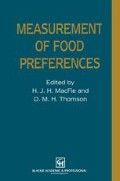Abstract
How do we measure food preferences? This is the general title of the book, and each chapter attempts to address this question in a different way. Some might say that measurement of food preferences is intrinsically easy — people generally know what they like and dislike. However, understanding why consumers like one thing and dislike another is not so easy. Such understanding is vital in any ‘real-life’ commercial context; marketing, advertising, new product development, product positioning and product tracking all require that food manufacturers understand their market, their product’s place in that market and the characteristics that define that product relative to others.
Access this chapter
Tax calculation will be finalised at checkout
Purchases are for personal use only
Preview
Unable to display preview. Download preview PDF.
References
Arnold, G.M. and Williams, A.A. (1986) The use of generalised Procrustes techniques in sensory analysis, in J.R. Piggott, (ed.) Statistical Procedures in Food Research, Elsevier Applied Science, London, pp. 233–53.
Bannister, D. and Fransella, F. (1986) Inquiring Man: The Psychology of Personal Constructs, Croom Helm, New York.
Berkeley, G. (1710) An Essay Towards a New Theory of Vision, Dublin.
Chatfield, C. and Collins, A.J. (1980) Introduction to Multivariate Analysis, Chapman and Hall, London.
Fransella, F. and Bannister, D. (1977) A Manual for Repertory Grid Technique, Academic Press, London.
Gains, N. (1989) The integration of personal construct theory in food acceptability research, PhD thesis, University of Reading, UK.
Gains, N. and Thomson, D.M.H. (1990a) Contextual evaluation of canned lagers using repertory grid method. International Journal of Food Science and Technology, 25, 699–705.
Gains, N. and Thomson, D.M.H. (1990b) The relation of repertory grid generalised Procrustes analysis solutions to the dimensions of perception: Application to Munsell color stimuli. Journal of Sensory Studies, 5, 177–92.
Gains, N., Krzanowski, W.J., and Thomson, D.M.H. (1988) A comparison of variable reduction techniques in an attitudinal investigation of meat products. Journal of Sensory Studies, 3, 37–48.
Gower, J.C. (1975) Generalized Procrustes analysis. Psychometrika, 40, 33–51.
Hinkle, D. (1965) The change of personal constructs from the viewpoint of construct implications, PhD thesis, Ohio State University, USA.
Hughes, G.D. (1974) The measurement of beliefs and attitudes, in R. Ferber, (ed.) Handbook of Marketing Research, Appleton-Century-Crofts, New York, pp. 316–43.
Hurley, J.R. and Cattell, R.B. (1962) The Procrustes program: producing direct rotation to test a hypothesised factor structure. Behavioural Science, 7, 258–62.
Kelly, G.A. (1955) The Psychology of Personal Constructs. WW & Norton Co., New York.
Kelly, G.A. (1963) Nonparametric factor analysis of personality theories. Journal of Individual Psychology, 19, 115–47.
Landfield, A.W. (1971) Personal Construct Systems in Psychotherapy,Rand McNally, New York.
McEwan, J.A. and Thomson, D.M.H. (1988a) A behavioural interpretation of food acceptability. Food Quality and Preference, 1, 4–11.
McEwan, J.A. and Thomson, D.M.H. (1988b) An investigation of the factors influencing consumer acceptance of chocolate confectionery using the repertory grid method, in D.M.H. Thomson, (ed.) Food Acceptability, Elsevier Applied Science, London, pp. 347–62.
McEwan, J.A. and Thomson, D.M.H. (1989) The repertory grid method and preference mapping in market research: a case study on chocolate confectionery. Food Quality and Preference, 1(2), 59–68.
Schutz, H.G. (1988) Beyond preference: Appropriateness as a measure of contextual evaluation of food, in D.M.H. Thomson (ed.), Food Acceptability, Elsevier Applied Science, London, pp. 115–34.
Scriven, F.M., Gains, N., Green, S.R., and Thomson, D.M.H. (1989) A contextual evaluation of alcoholic beverages using the repertory grid method. International Journal of Food Science and Technology, 24, 173–82.
Slater, P. (1964) The Principal Components of a Repertory Grid, Vincent Andrews, London.
Slater, P. (1977) The Measurement of Intrapersonal Space By Grid Technique, Vols 1 and 2, Wiley, Chichester.
Thomson, D.M.H. and McEwan, J.A. (1988) An application of the repertory grid method to investigate consumer perceptions of foods. Appetite, 10, 181–93.
Williams, A.A. and Langron, S.P. (1984) Use of free-choice profiling for evaluation of commercial ports. Journal of the Science of Food and Agriculture, 35, 558–68.
Editor information
Editors and Affiliations
Rights and permissions
Copyright information
© 1994 Springer Science+Business Media Dordrecht
About this chapter
Cite this chapter
Gains, N. (1994). The repertory grid approach. In: MacFie, H.J.H., Thomson, D.M.H. (eds) Measurement of Food Preferences. Springer, Boston, MA. https://doi.org/10.1007/978-1-4615-2171-6_3
Download citation
DOI: https://doi.org/10.1007/978-1-4615-2171-6_3
Publisher Name: Springer, Boston, MA
Print ISBN: 978-1-4613-5908-1
Online ISBN: 978-1-4615-2171-6
eBook Packages: Springer Book Archive

